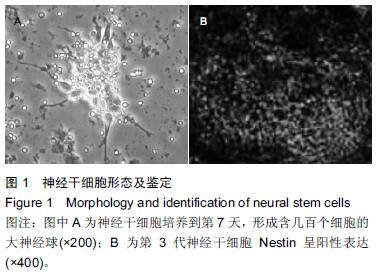| [1] 吴云.小儿脑性瘫痪的发病机制及诊治进展[J].安徽医学, 2011,32(6):859-862. [2] 罗华英.头颅CT在小儿脑瘫诊断中的作用[J].江西医药, 2009,44(3):271-272. [3] 胡春维,张斌,秋艳萍,等.脑性瘫痪198例临床分析[J].陕西医学杂志,2010,39(7):887-888. [4] 殷方明,史敏康,史丽峰.神经节苷脂治疗新生儿中重度缺氧缺血性脑病疗效观察[J].现代中西医结合杂志.2010, 19(14):1739-1740. [5] 宋令瑄.神经节苷酯辅助治疗小儿脑瘫的临床研究[J].中国实用神经疾病杂志,2009,12(17):63-64. [6] 怀智勇.小儿痉挛型脑瘫的中西医治疗概况[J].按摩与康复医学:下旬刊,2012,3(1):47-48. [7] 王艳,唐强,李晓艳,等.小儿脑瘫的康复研究进展[J].中国康复,2010,25(6):470-472. [8] 汪美君,兰金山,李胜.播放音乐对局部麻醉鼻内镜手术患者焦虑及疼痛的影响[J].护理与康复,2011,10(10):844- 845. [9] 张超,芮芳,唐久来,等.小儿脑性瘫痪影响因素与临床类型的关系[J].安徽医学,2010,31(7):719-722. [10] 张健,赵澎.小儿脑瘫的中医研究近况[J].医学综述,2010, 16(7):1092-1095. [11] 李晓捷.关注小儿脑性瘫痪中西医康复疗法的实践与研究[J]. 中国中西医结合儿科学,2010,2(1):1. [12] Zheng XR, Zhang SS, Yin F, et al. Neuroprotection of VEGF-expression neural stem cells in neonatal cerebral palsy rats. Behav Brain Res. 2012;230(1): 108-115. [13] Azari H, Rahman M, Sharififar S, et al. Isolation and expansion of the adult mouse neural stem cells using the neurosphere assay. J Vis Exp. 2010;(45). pii: 2393. [14] Deleyrolle LP, Reynolds BA. Isolation, expansion, and differentiation of adult Mammalian neural stem and progenitor cells using the neurosphere assay. Methods Mol Biol. 2009;549:91-101. [15] Azari H, Osborne GW, Yasuda T, et al. Purification of immature neuronal cells from neural stem cell progeny. PLoS One. 2011;6(6):e20941. [16] Louis SA, Mak CK, Reynolds BA. Methods to culture, differentiate, and characterize neural stem cells from the adult and embryonic mouse central nervous system. Methods Mol Biol. 2013;946:479-506. [17] Xu N, Papagiannakopoulos T, Pan G, et al. MicroRNA-145 regulates OCT4, SOX2, and KLF4 and represses pluripotency in human embryonic stem cells. Cell. 2009;137(4):647-658. [18] Yue F, Chen B, Wu D, et al. Biological properties of neural progenitor cells isolated from the hippocampus of adult cynomolgus monkeys.Chin Med J (Engl). 2006;119(2):110-116. [19] Fansa H, Keilhoff G. Comparison of different biogenic matrices seeded with cultured Schwann cells for bridging peripheral nerve defects. Neurol Res. 2004; 26(2):167-173. [20] Rosenblum S, Wang N, Smith TN, et al. Timing of intra-arterial neural stem cell transplantation after hypoxia-ischemia influences cell engraftment, survival, and differentiation. Stroke. 2012;43(6): 1624-1631. [21] Daadi MM, Davis AS, Arac A, et al. Human neural stem cell grafts modify microglial response and enhance axonal sprouting in neonatal hypoxic-ischemic brain injury. Stroke. 2010;41(3):516-523. [22] Lee JS, Hong JM, Moon GJ, et al. A long-term follow-up study of intravenous autologous mesenchymal stem cell transplantation in patients with ischemic stroke. Stem Cells. 2010;28(6):1099-1106. [23] Tan JL, Zheng XR, Zhang SS, et al.Response of the sensorimotor cortex of cerebral palsy rats receiving transplantation of vascular endothelial growth factor 165-transfected neural stem cells. Neural Regen Res. 2014;9 (19): 1763-1769. [24] Amit M, Chebath J, Margulets V, et al. Suspension culture of undifferentiated human embryonic and induced pluripotent stem cells. Stem Cell Rev. 2010; 6(2):248-259. [25] van Velthoven CT, Kavelaars A, van Bel F, et al. Nasal administration of stem cells: a promising novel route to treat neonatal ischemic brain damage. Pediatr Res. 2010;68(5):419-422. [26] 栾佐,屈素清,刘卫鹏,等.人神经干细胞移植治疗重度视觉障碍脑瘫患儿的临床观察[J].中国康复理论与实践,2007, 13(12): 1103-1105. [27] Wei L, Fraser JL, Lu ZY, et al. Transplantation of hypoxia preconditioned bone marrow mesenchymal stem cells enhances angiogenesis and neurogenesis after cerebral ischemia in rats. Neurobiol Dis. 2012; 46(3):635-645. [28] Li M, Yu A, Zhang F, et al. Treatment of one case of cerebral palsy combined with posterior visual pathway injury using autologous bone marrow mesenchymal stem cells.J Transl Med. 2012;10:100. [29] Lu D, Chen B, Liang Z, et al. Comparison of bone marrow mesenchymal stem cells with bone marrow-derived mononuclear cells for treatment of diabetic critical limb ischemia and foot ulcer: a double-blind, randomized, controlled trial. Diabetes Res Clin Pract. 2011;92(1):26-36. [30] 杜侃,栾佐,屈素清,等.骨髓间充质干细胞移植治疗小儿重度脑性瘫痪的疗效观察[J].临床儿科杂志,2011,29(1): 55-58. [31] Sun J, Allison J, McLaughlin C, et al. Differences in quality between privately and publicly banked umbilical cord blood units: a pilot study of autologous cord blood infusion in children with acquired neurologic disorders. Transfusion. 2010;50(9):1980-1987. [32] Lee YH, Choi KV, Moon JH, et al. Safety and feasibility of countering neurological impairment by intravenous administration of autologous cord blood in cerebral palsy. J Transl Med. 2012;10:58. [33] 杨华强,张荣环,杜玲,等.脐带间充质干细胞移植对脑瘫患儿运动功能的影响[J].现代生物医学进展,2012,12(2): 250-252. [34] Jensen A, Hamelmann E. First autologous cell therapy of cerebral palsy caused by hypoxic-ischemic brain damage in a child after cardiac arrest-individual treatment with cord blood. Case Rep Transplant. 2013; 2013:951827. [35] 吴景文,贾丹兵,曲超法,等.干细胞移植治疗小儿脑瘫的临床疗效:40例报告[J].中华神经外科疾病研究杂志,2011, 10(5):424-427. [36] 栾佐.新生动物及其缺血性脑损伤神经干细胞移植的研究现状[J].中华儿科杂志,2004,42(4):305-308. [37] 杨万章,吴芳,张敏,等.脐血源神经干细胞移植治疗神经系统疾病临床总结和分析[J].中西医结合心脑血管病杂志, 2009,7(3):287-290. [38] Nakamura M, Toyama Y, Okano H.Transplantation of neural stem cells for spinal cord injury.Rinsho Shinkeigaku. 2005;45(11):874-876. |
.jpg)


.jpg)